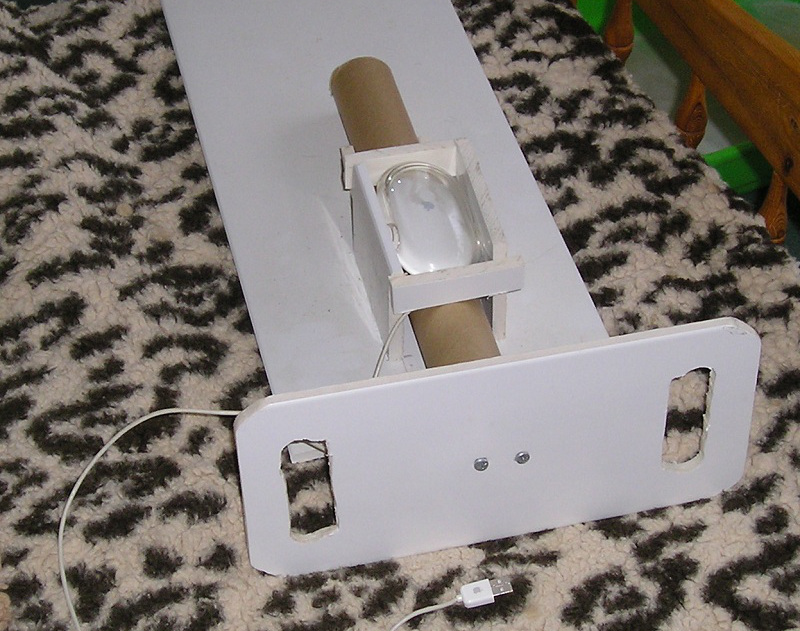When it comes to flight simulators, we’ve seen people go all-out with their immersive setups, with all kinds of hyper-realistic control systems and monitors as far as the eye can see. But for those gaming on a budget this can seem a little overwhelming and daunting. We all have to start somewhere, though, so if you’re looking for your first semi-realistic flight simulator control mechanism take a look at this yoke which can be cobbled together for almost no money or time.
The yoke can be built around any optical mouse that happens to be lying around. A custom housing for it is constructed from cardboard, which lets it sit above a cardboard tube which functions as the control interface. This mechanism rests in a cardboard box it uses as a frame, with a yoke-styled control interface built out of packing foam at the front. One optional modification to the device allows it to have more realistic control throw, and another replaces the cardboard tube with a wooden dowel to give the device a little more strength.
While relatively quick and easy to build, it works as a fully-functional yoke in flight simulator programs like FlightGear almost effortlessly, mostly thanks to the fact that it is based on a nearly unmodified mouse. Assuming you have a mouse in your parts drawer and have access to some sort of cardboard, it’s estimated to take not much longer than five minutes to put together. But if you’re looking for something DIY that’s a little more substantial, it’s not too much of a step up to another DIY yoke we’ve featured before which is centered around an Arduino and a few 3D-printed parts.
Thanks to [Stephen] for the tip!

















This is very creative!
Q: What did the angry mouse say to the human?
A: Am I a yoke to you?
:-)
I also tried to build a flight yoke with a mouse (difference was that I placed the mouse upside down) – but never got past the concept stage. Probably because I wanted a self-centering “arcade yoke” (with springs), with easily reachable buttons on the yoke itself. Stuff got too complicated too fast…so, naturally, I love this utterly minimalistic design!
There was a similar thing a long time ago where a guy attached a mousse to a stick attached to his desk and then under the mouse he put a stool that rotates under it so he had a budget steering wheel since the mouse detected the rotating surface.
You can of course make that as fancy as you want, as long as you have a round thing that rotates and a mouse that stays stationary.
I really should try that myself some time because I wonder how well that works in practise, it should work fine.
This is very clever, but I’m worried that because the mouse collects and sends differential data, positional errors will be compounded as one moves the yoke, until eventually the physical yoke will drift significantly out of sync with the simulated yoke.
(Note, by the way, that it’s necessary to turn off mouse acceleration, or else things will get out of sync right away.)
Here’s another idea. Build the yoke the same way, but omit the mouse. Put four IR LEDs at the corners of the yoke. Point a Wii Remote’s IR camera to track the LEDs, and then calculate yoke positioning from the four LED images. No problem with drift, though the movement sensitivity will be quite a bit lower.
Yes, further complicating the design is always an option.
With a second free mouse you can center things now and then.
Many Sims have a hot key for this.
It might be a pain to obtain one but one of the early optical mice that uses a patterned pad to obtain absolute XY coordinates would solve this.
Simple end switch and a software reset would do it.
Not that I EVER see my mouse drift.
Maybe you need to get it a vehicle that drifts better.
Try the cardboard tube from Glad Cling Wrap. It is stronger than the tubes from paper towels.
What a yoke…
Imma show myself out…
I already made the (awful) joke.
Albeit packaged slightly differently.
“minimalism separates the wheat from the chaff”
”There should be an award on hackaday for the most minimalist of hacks. The most achieved with the minimalest of equipment and effort.
I nominate this yoke for that award.
So it’s a cardboard version of Mouse Yoke made by Colorado Spectrum in mid 90’s? There is a video of one on youtube!